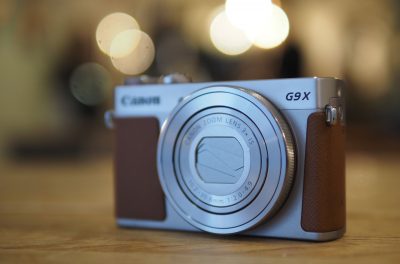Canon G9X review
-
-
Written by Gordon Laing
Quality
The performance of the Sony 1in / 20 Megapixel sensor is well-known from earlier reviews, but what’s different here on the G9X is its lens. So on this page I’ve tested it at three different focal lengths representing wide, mid and telephoto, to see how it measures-up. As always I recorded my test shots in RAW+JPEG and once supported in Adobe Camera RAW I’ll take a look at the RAW files to see if any improvements can be made. For now, we’re looking at JPEGs out-of-camera using the default settings, which to be fair is how most of the G9X’s owners will probably use it.
My first table looks at the G9X when the lens is set to its widest focal length, delivering coverage equivalent to 28mm. I took the scene below at all apertures and found the crispest overall were at the maximum f2 focal ratio and when closed one stop to f2.8. Closing the aperture further did nothing to improve corner sharpness and, as expected, increased the softening effect due to diffraction. As always the crops are taken from the rectangles marked in red below and are presented at 100%.
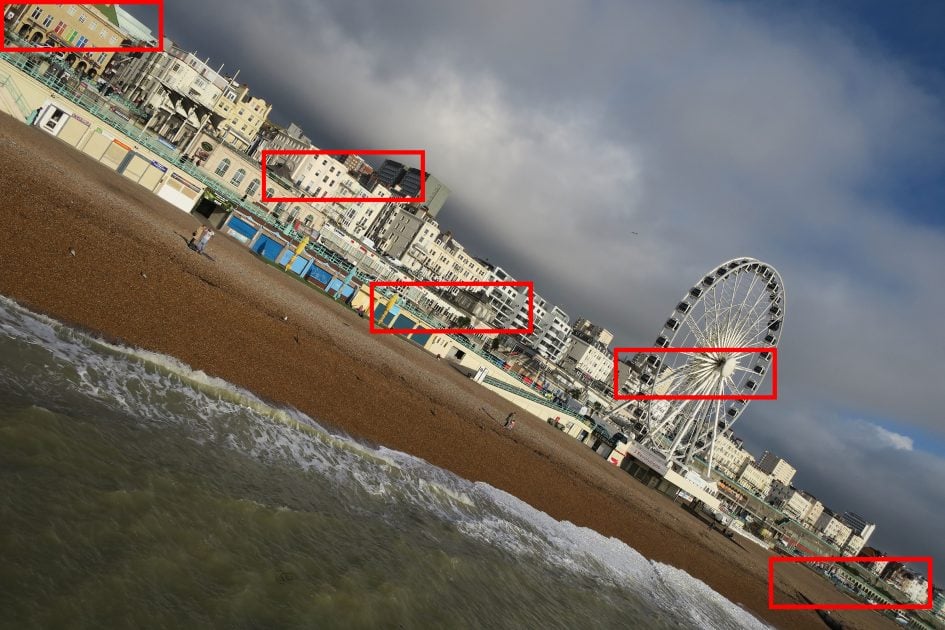
At 28mm equivalent the G9X is a little soft in the corners, which no amount of aperture adjustment will resolve. Move away from the corners a little though and the sharpness improves greatly and as you approach the centre of the frame the camera is delivering crisp and detailed results.
Look closely and you’ll also notice some noise in the shadow areas even at the base sensitivity of 125 ISO. To be fair this is par for the course for a 1in sensor camera where the noise performance is roughly between a point-and-shoot and a larger format interchangeable lens camera. As such it won’t match the cleanliness of APS-C or even Micro Four Thirds, but importantly it’s cleaner than the output from typical 1/2.3in or 1/1.7in products, especially at higher ISOs.

Above: Canon G9X, 100% crop from JPEG at 28mm equiv, f2.8, 125 ISO

Above: Canon G9X, 100% crop from JPEG at 28mm equiv, f2.8, 125 ISO

Above: Canon G9X, 100% crop from JPEG at 28mm equiv, f2.8, 125 ISO

Above: Canon G9X, 100% crop from JPEG at 28mm equiv, f2.8, 125 ISO

Above: Canon G9X, 100% crop from JPEG at 28mm equiv, f2.8, 125 ISO
Lower on this page I have two more comparisons at roughly 50mm and the longest focal length of 84mm. I’d urge you to take a look as the optical quality is superior than the widest focal length here. If you have seen enough though, scroll down for my Canon G9X noise results, my Canon G9X sample images, or skip back to my verdict.
Canon PowerShot G9X quality at 52mm
To test the G9X roughly mid-way through its focal range I zoomed the camera to 52mm equivalent and took the following composition at all aperture values. As before, the best results were with the aperture either wide-open or only closed by a stop, so in this case in the f4 to 5.6 region. I didn’t notice any difference between them for this composition, so have chosen the larger of the two here. As always the crops are taken from the areas marked by red rectangles and presented in the table below at 100%.
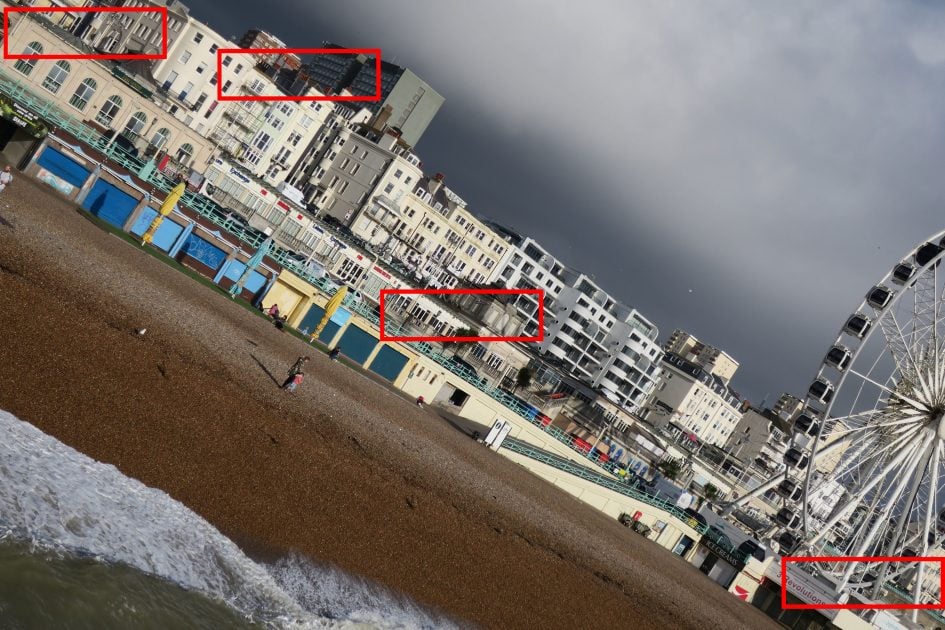
The crops below reveal the G9X delivers much more consistent sharpness across the frame at 52mm than it did at 28mm. Essentially there’s no softness in the corners to complain about here, with the image containing a high degree of detail throughout. As before there’s some visible noise in the shadow areas, something that’s evident on all 1in-sensor cameras, but the output here is still very satisfactory.

Above: Canon G9X, 100% crop from JPEG at 52mm equiv, f4, 125 ISO

Above: Canon G9X, 100% crop from JPEG at 52mm equiv, f4, 125 ISO

Above: Canon G9X, 100% crop from JPEG at 52mm equiv, f4, 125 ISO

Above: Canon G9X, 100% crop from JPEG at 52mm equiv, f4, 125 ISO
Scroll down to see how it performs at its longest focal length of 84mm, or if you’ve seen enough, scroll down for my Canon G9X noise results, my Canon G9X sample images, or skip back to my verdict.
Canon PowerShot G9X quality at 84mm
To test the G9X at its longest focal length, I zoomed the lens to 84mm equivalent and took the following composition at all aperture values. As before, the best results were with the aperture either wide-open or closed a little, so in this case in the f4.9 to 5.6 region. In this composition I noticed fractionally better sharpness when closed to f5.6, so that’s what I’ve gone for here. As always the crops are taken from the areas marked by red rectangles below and presented in the table lower down at 100%.
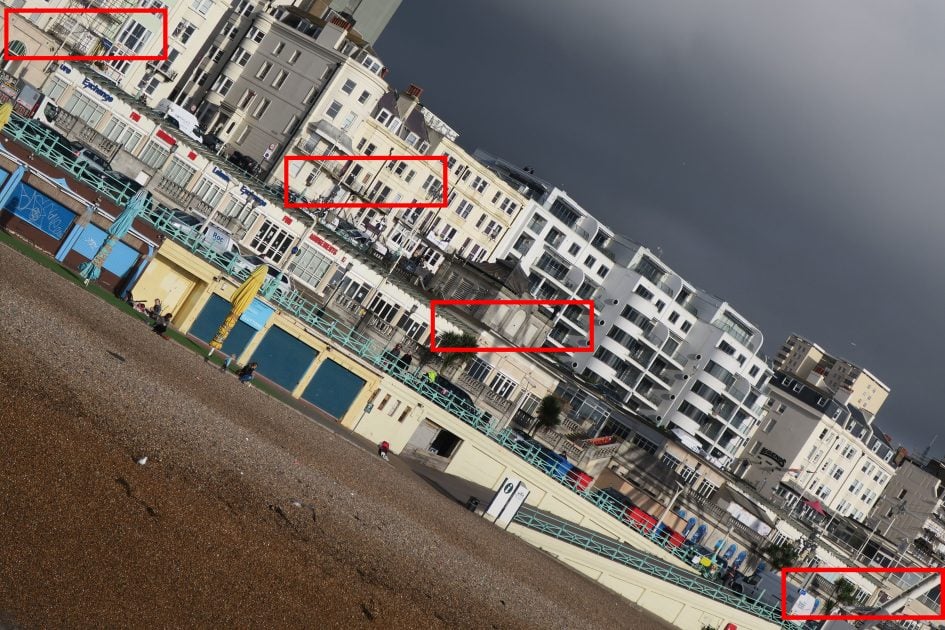
Look closely and there’s a fractional drop in sharpness in the extreme corners compared to the centre when zoomed to 84mm, but it’s nowhere near as noticeable as at the wide end of the range. Certainly I’d be happy with the results, which crisp-up quickly as you move only a fraction from the corners. As before there’s a high degree of detail, and while there’s some noise in the shadow areas, it’s still cleaner than cameras with smaller sensors.
Overall I’d say given the compromises of a small body, the G9X delivers very good image quality. While I feel the out-of-camera output from the (much more expensive) Sony RX100 IV is a little sharper, the G9X produces very satisfying photos with little effort. It’s a little soft in the extreme corners when zoomed wide to 28mm, but as you approach mid-way through the range the sharpness becomes very consistent across the frame. At the long-end some corner softness returns, but it’s not as noticeable as at 28mm.

Above: Canon G9X, 100% crop from JPEG at 84mm equiv, f5.6, 125 ISO

Above: Canon G9X, 100% crop from JPEG at 84mm equiv, f5.6, 125 ISO

Above: Canon G9X, 100% crop from JPEG at 84mm equiv, f5.6, 125 ISO

Above: Canon G9X, 100% crop from JPEG at 84mm equiv, f5.6, 125 ISO
Next check out my Canon G9X noise results, my Canon G9X sample images or skip back to my verdict.
Canon PowerShot G9X noise results
The performance of the Sony 1in / 20 Megapixel sensor housed within the Canon G9X is already well-known from earlier reviews, but it’s still important to see how it measures-up in a new body with a new lens and potentially updated processing.
So on this page I tested the G9X at every sensitivity from 125 to 12800 ISO, recording the image in RAW+JPEG mode. Once supported in Adobe Camera RAW I’ll take a look at the RAW files to see if any improvements can be made. For now, we’re looking at JPEGs out-of-camera using the default settings, which to be fair is how most of the G9X’s owners will probably use it.
The following composition was taken at 34mm equivalent with the aperture closed a little to f4. As always the cropped area is marked by the red rectangle below and presented in the table at 100%.
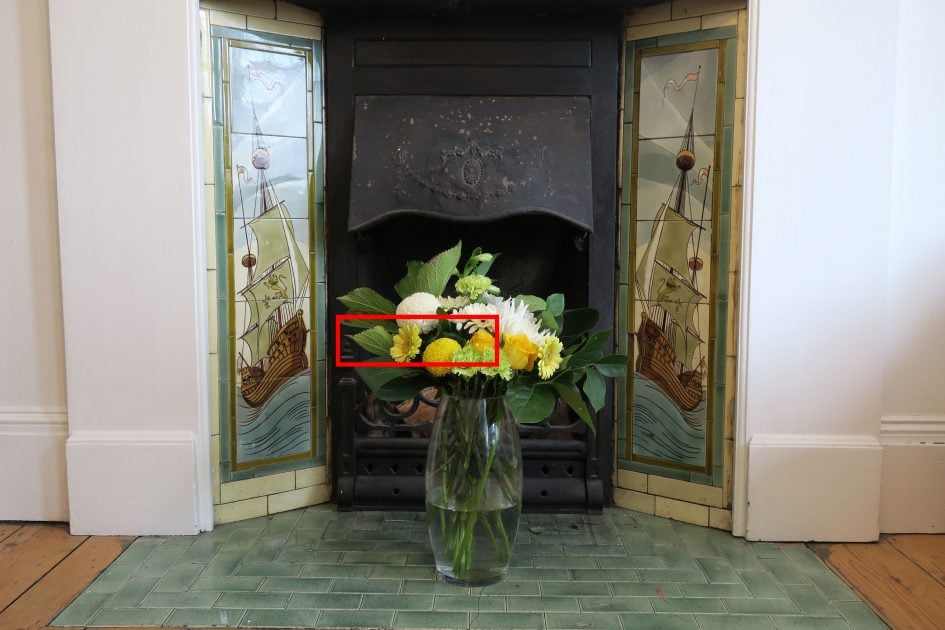
At the base sensitivity of 125 ISO the G9X delivers crisp and clean results which are deeper and better-saturated than those from smaller sensor cameras. This continues at 200 ISO and while they may be at the low-end of the sensitivity range, the quality in tone, colour and noise is still a step-up from basic point-and-shoot cameras – the whole reason you’d want to go for a 1in sensor camera in the first place.
At 400 ISO there’s a small drop in quality with a slight softening of detail and increase in visible noise, but the results still look good. At 800 ISO there’s another small drop in quality, but again I’d be happy with the output.
The increase to 1600 ISO brings a noticeable reduction in quality: fine details in the flowers and leafs are being lost to noise and processing, and edges are becoming less distinct. I’d say this is the top sensitivity you’d want to use if you demand good quality and close examination.
From 3200 ISO onwards the 1in sensor is visibly suffering with progressively less detail and more noise. 6400 ISO sees a further big drop in quality and the jump to the maximum 12800 ISO another major fall.
Ultimately the G9X performs as expected, in-line with previous 1in products from Canon. It looks good up to 400 ISO and only loses a little quality between there and 1600 ISO, giving the camera a useful range of sensitivities to deploy without significantly impacting the quality. I feel Sony manages to extract slightly crisper results still without compromising visible noise on its RX100 series and the company is also deploying a newer version of the sensor in the latest RX100 IV. For ultimate image quality with this sensor size I think Sony knows how to get the best from its technology, but Canon is still doing a good job, and certainly viewed here the G9X is delivering very good quality images.
Crucially the 1in sensor in the G9X is doing what it’s supposed to do in this type of camera: namely delivering cleaner results with greater saturation and better tonal detail than cameras with smaller sensors. As such it delivers a genuine step-up in quality over typical point-and-shoot compacts or phones, but the greatest gains over these models are at higher sensitivities; if you mostly or even only shoot at very low ISOs, you can still achieve very good quality from models like Canon’s own S120.

Above: Canon G9X, 100% crop from JPEG at 125 ISO

Above: Canon G9X, 100% crop from JPEG at 200 ISO

Above: Canon G9X, 100% crop from JPEG at 400 ISO

Above: Canon G9X, 100% crop from JPEG at 800 ISO

Above: Canon G9X, 100% crop from JPEG at 1600 ISO

Above: Canon G9X, 100% crop from JPEG at 3200 ISO

Above: Canon G9X, 100% crop from JPEG at 6400 ISO

Above: Canon G9X, 100% crop from JPEG at 12800 ISO
Next check out my sample images or skip back to my verdict.




